With Shio Koji, a natural seasoning used in Japanese cooking, you can make EASY & DELICIOUS Shio Koji Chicken in no time with just 4 ingredients!
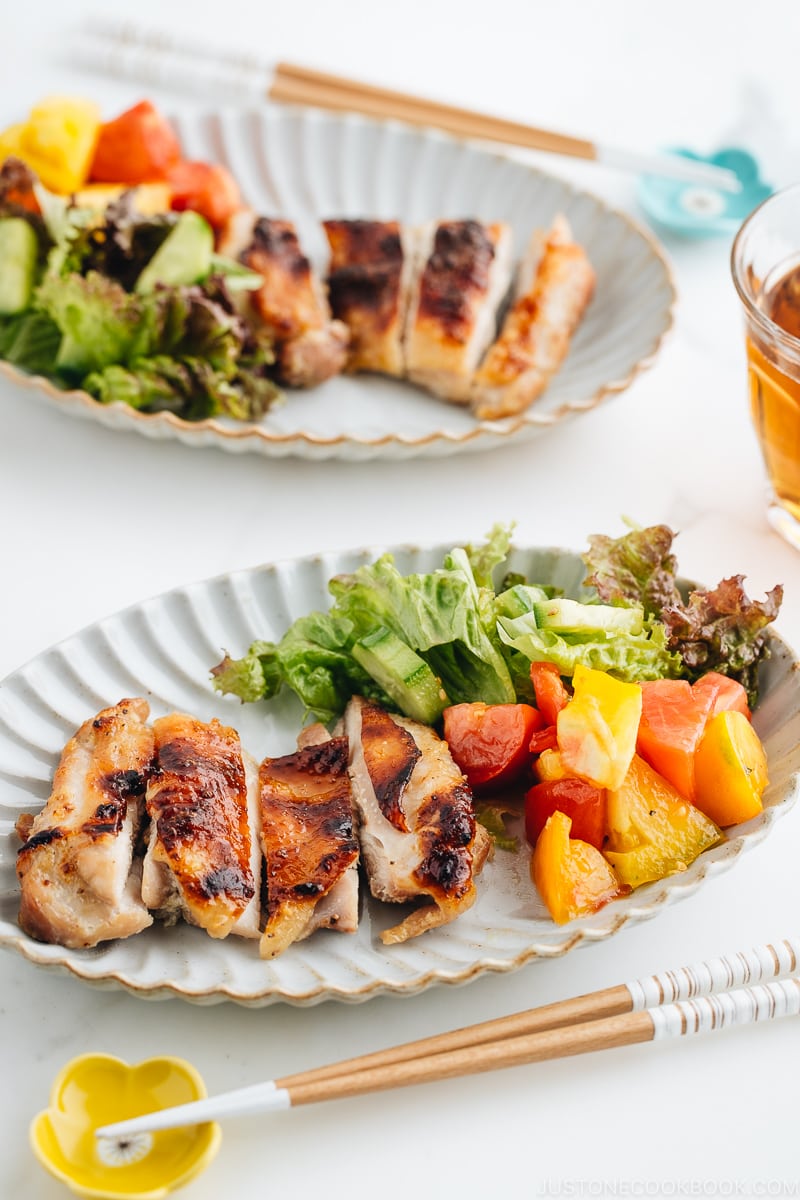
Sometimes a simple ingredient or condiment is all it takes to lend a magical touch on a dish. Garlic, ginger, miso, yuzu kosho, and sriracha are just some fantastic examples. And if you haven’t heard of Shio Koji, allow me to introduce this seasoning to you today. I’ve pulled off an incredibly amazing Shio Koji Chicken (塩麹チキン) that takes only 4 ingredients to make.
All thanks to Shio Koji, I get an umami-packed delicious chicken on the table with minimal effort. It is that WOW! You will want to have it in your pantry at all time too.
What is Shio Koji?
Shio Koji (塩麹, 塩糀) is a natural seasoning that we use to marinate, tenderize, and enhance the umami in foods. It’s made of just a few simple ingredients: salt, water, and rice koji.
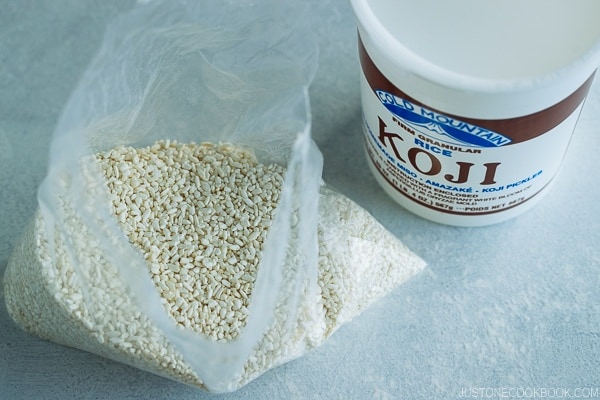
One of Shio Koji’s ingredient, rice koji, or Kome Koji (米こうじ, 米糀, 米麹) in Japanese, is steamed rice that has been treated with koji mold spores (Aspergillus oryzae, koji-kin 麹菌, or koji starter).
Koji – Mold that You’ve Eaten Before
Koji is a specific strain of mold that has been cultured over the centuries. You may feel hesitant reading all about mold and wonder why we make rice moldy on purpose. But guess what, you have most likely eaten it already!
Koji has been the key ingredient to make miso, soy sauce, sake, mirin, rice vinegar, amazake, shochu, and today’s star, shio koji.
Why do we use koji in cooking? Because it’s a live food that is rich in enzymes. And we need enzymes to break down starches and proteins in food into sugars and amino acids. This process makes the food naturally sweet, aromatic, and rich in umami.
Health Benefits of Shio Koji:
Because it is a fermented ingredient, shio koji is known for its many health benefits, which includes (source):
- A natural pro-biotic seasoning
- Tenderizes food
- Brings out the umami and sweetness in foods
- Reduces the intake of salt
- Aids for digestion
- Clear the skin
- Anti-aging
- Contains minerals, fiber, and vitamins
How to Use Shio Koji
You can use shio koji to marinate your meats and vegetables, make pickles, or use it as a salt substitute. Shio koji is REALLY versatile and I’ve used it to make some delicious recipes on Just One Cookbook.
If you’re not sure, start using shio koji to replace salt. In a recipe that calls for one teaspoon of salt, you can substitute with 2 teaspoons of Shio Koji. You will not only get the “salt” effect but also experience the “umami bomb” effect!
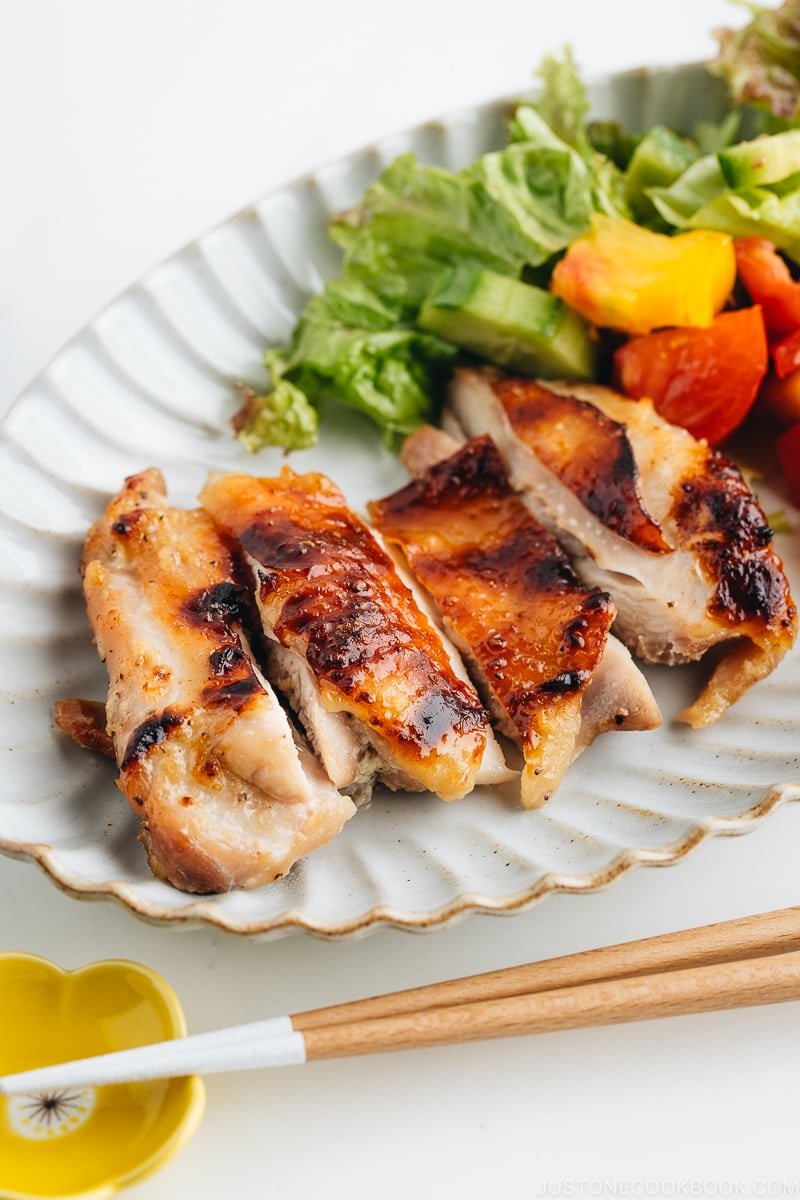
Get a Bottle of Shio Koji and Start Cooking!
After sharing several recipes that require rice koji, I learned from readers that it’s actually a lot easier to get Shio Koji from Hikari Miso®. It’s available in Japanese grocery stores and Amazon as well as a big Korean grocery chain, H-Mart. Unlike Japanese grocery stores, this Korean grocery chain has many locations throughout North America. You may find it on the shelf or refrigerated section of the store.
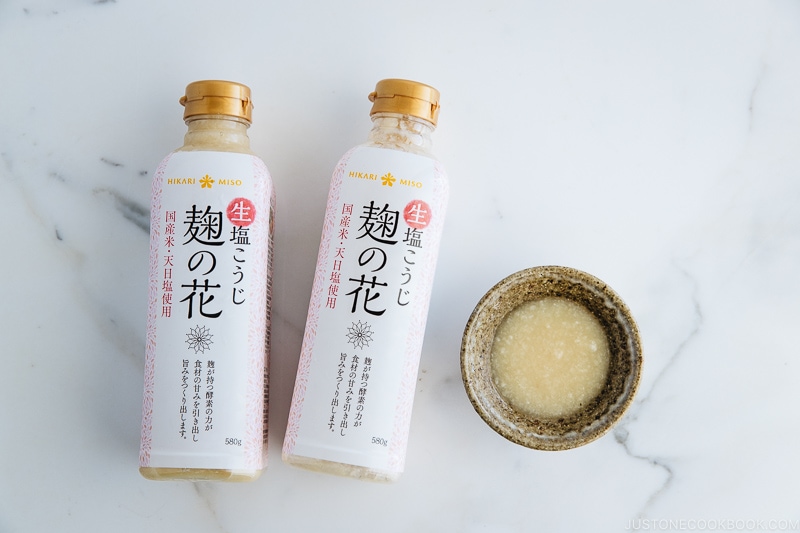
When you open the bottle, you will immediately notice the sweet smell that reminds you of sake. With the help of all-natural koji, you will notice the significant flavor boost in your daily cooking!
Craving for More Shio Koji Recipes?
- Shio Koji Karaage – it’s a must-try!
- Shio Koji Yakisoba
- Shio Koji Simmered Kabocha
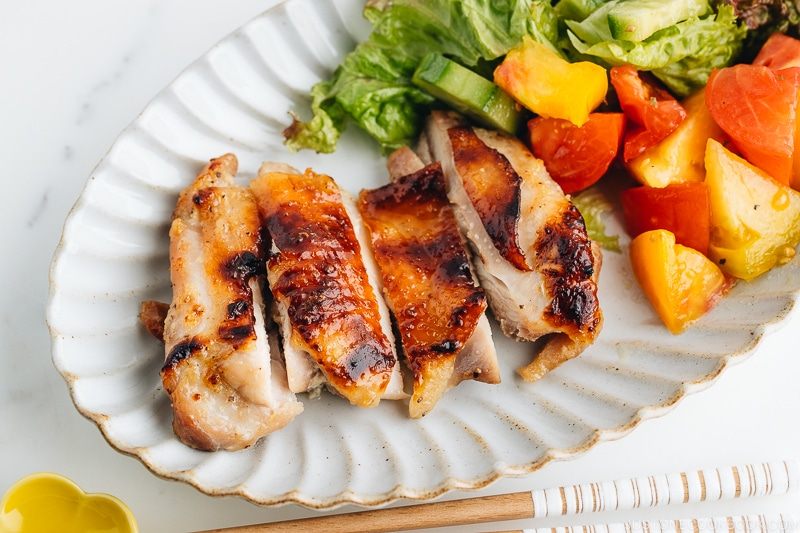
Wish to learn more about Japanese cooking? Sign up for our free newsletter to receive cooking tips & recipe updates! And stay in touch with me on Facebook, Pinterest, YouTube, and Instagram.
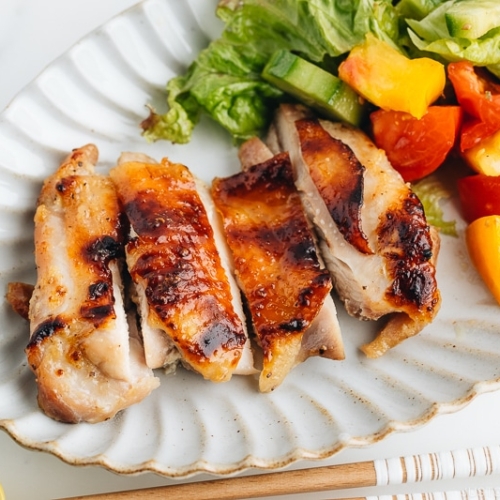
Shio Koji Chicken
Ingredients
- 8 pieces boneless, skin-on chicken thighs (or use bone-in, skin-on chicken thighs and ask the butcher to remove the bones)
- 1 cup shio koji
- 1 Tbsp soy sauce
- freshly ground black pepper
Instructions
- Gather all the ingredients.

To Marinate
- Combine 1 cup shio koji and 1 Tbsp soy sauce in a bowl or measuring cup.

- Season both sides of 8 pieces boneless, skin-on chicken thighs with freshly ground black pepper.

- Pour the shio koji mixture on the chicken pieces and coat them well on both sides. Cover and let it marinate in the refrigerator for 30 minutes (minimum) or up to 3 hours.

To Bake
- Preheat the oven to 350ºF (180ºC). For a convection oven, reduce cooking temperature by 25ºF (15ºC). Remove the shio koji as much as possible and transfer to a baking sheet lined with parchment paper.

- If your oven doesn‘t come with a temperature probe, you can use a ThermoWorks Chef Alarm. Insert the stem of the probe into the thickest part of the chicken, or in the center of the chicken if it is even in thickness.

- Bake at 350ºF (180ºC) until the internal temperature of the chicken reaches to 165ºF (74ºC), roughly 25 minutes.

- Once the chicken is cooked through, change the oven setting from Bake to Broil. Broil the chicken until the skin has nice char, about 3–5 minutes (depends on how far the chicken is from the heat source). Remove from the oven.

- Cut each chicken thigh into 4 pieces (if you eat with chopsticks) and serve immediately.

To Store
- You can keep the leftovers in an airtight container and store in the refrigerator for up to 4 days and in the freezer for 2–3 months.
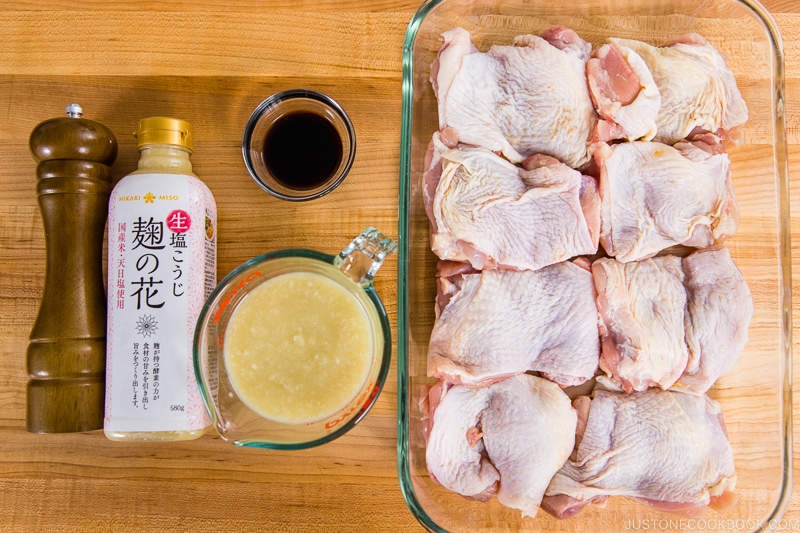

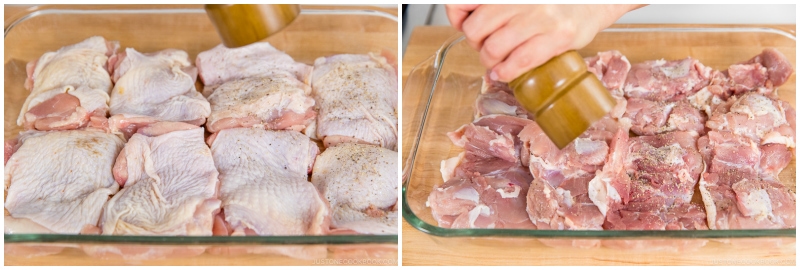
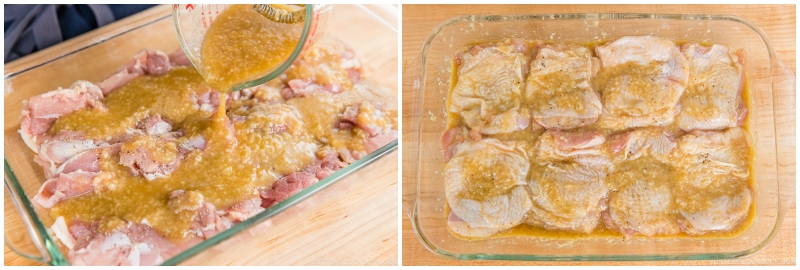
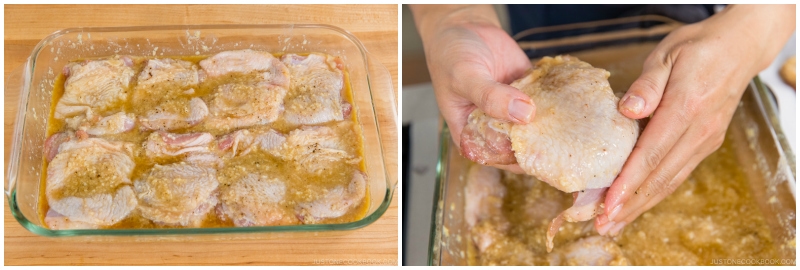
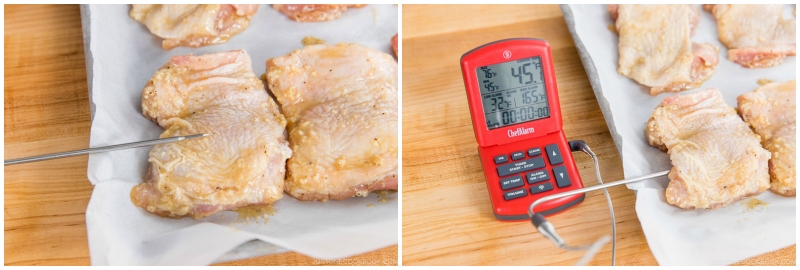
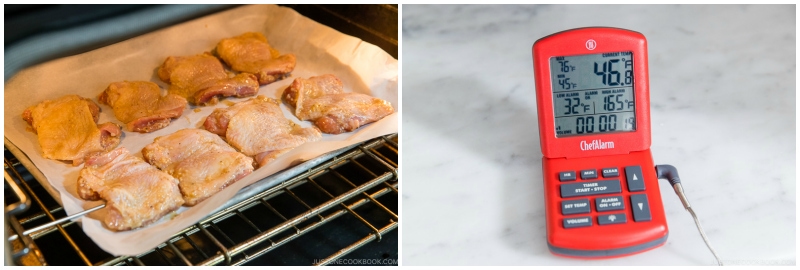
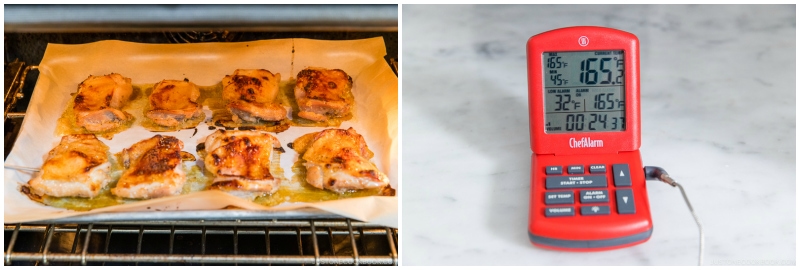
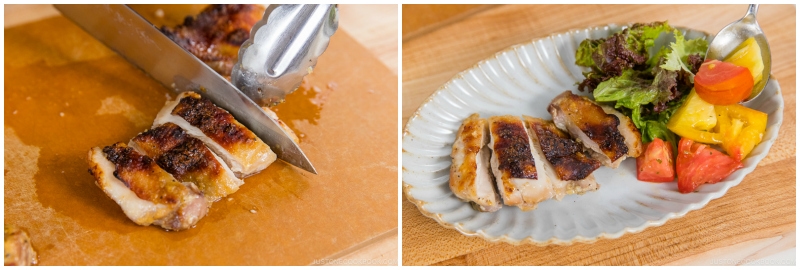










Made this with boneless skinless breasts. I used equal parts soy and saki, added a bit of sugar. Grilled. Outstanding.
Hi Jeff! Thank you so much for your kind feedback!
We are glad to hear you enjoy the dish. Happy Cooking!
Hello Naomi-san. Is it just as good with bone in thighs? I am thinking of cooking the thighs on my Traeger pellet. Will that work?
Hi Rich, Thank you so much for trying Nami’s recipe!
Sure. You can use the bone-in chicken thighs, but the cooking time will be slightly longer than in this recipe.
We hope this helps!
When my wife or I make Shio Koji Chicken we also add mirin to the mixture in 1:1 ratio with the soy sauce.
Hi Tony! Thank you very much for sharing your cooking experience and tip with us!
Hi, Nami-san! Just wondering, can I use Liquid Shio Koji for this recipe? I know the difference is in texture, but is the final result similar in taste?
Btw, have to say, I LOVE YOUR RECIPES! Tried a bunch of them already and they are super tasty! Best wishes from Poland!!
Hi Aga! Thank you very much for trying Nami’s recipes!
Nami and JOC team are so happy to hear you love Nami’s recipes! 🥰
Yes, you can use liquid Shio Koji and you can get the same result.🙂 Happy Cooking!
Hi, I followed the Amazon link but the product you linked was out of stock so I naturally did a search for Shio Koji and its come up with a few options. Can you explain the difference between Liquid Shio Koji – Hanamaruki Liquid Shio Koji 500ml -Goes Well with Both Japanese and Western Dishes Making Daily Meals Delicious. : Amazon.co.uk: Grocery and “normal” ? – Hanamaruki Shio Koji Paste 230g -Salted Malted Rice Seasoning for Fish, Meat, Salad Dressing, Sauce etc : Amazon.co.uk: Grocery (links are amazon uk cos thats where I am 😀
Hi Brian, According to their website, Liquid Shio Koji is used as a marinade for meat and fish and seasoning for stewed or stir-fried dishes. Because it has no texter, it’s easy to use as seasoning. It is a condiment that can be used as “Dashi” and a replacement for salt and/or Say sauce.
The difference between the two is the texture. 🙂
We hope this helps!
Hi Naomi
Do you think this recipe could work using an air fryer?
Thanks,
Steve
Hi Steve! Thank you very much for trying Nami’s recipe!
Yes. You can use an air fryer. Try at 350~400ºF until the internal temperature of the chicken reaches 165ºF (74ºC). About roughly 25 minutes.
We hope this helps!
Thank you so much for making this so easy !!!
My children loved it too!
May I ask my first attempt was a tiny bit dry. Is that because I let it bake too long ?
Are there other reasons it may be dry.
Thank you in advance for your help and thank you so much for your wonderful website!
Hi Brendan, Thank you very much for trying Nami’s recipe! We are so happy to hear your family loved Shio Koji Chicken.
The chicken would be dry when it gets overcooked. When the chicken’s internal temperature reaches 165ºF (74ºC), It’s done and perfectly moist inside. We highly recommend using the thermometer for easy cooking.
We hope this helps!
Dear Namiko, is it possible to make this with skinless thighs?
Hi Ransi, Thank you very much for reading Nami’s post!
Yes. You may use skinless Chicken thighs for this recipe. Please feel free to adjust the cooking time.🙂